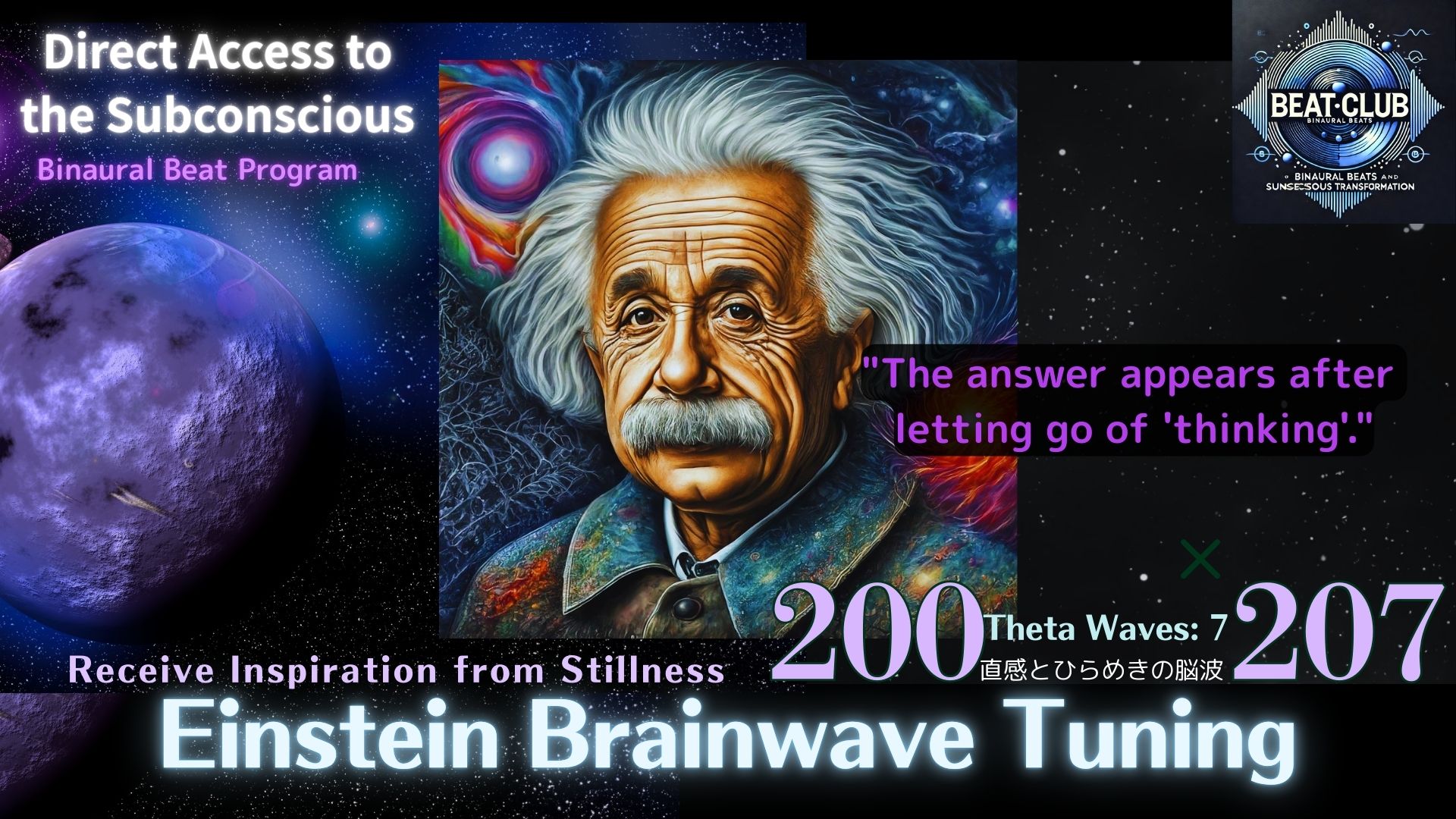─ The Sound That Awakens Inspiration from Silence ─
Welcome to a new series focusing on recreating the mindset and brainwave patterns of historical geniuses through sound-based tuning.
For the first edition, we turn our attention to the legendary physicist Albert Einstein.
Many of his ideas and intuitive insights are said to have arisen not through deliberate thinking, but from deep silence. So how can we replicate this “inspiration from stillness” in our modern lives?
In this article, we’ll introduce a binaural beat sound source inspired by Einstein’s state of mind, along with simple practices to help you enter a quiet state of inspiration.
What Was Einstein’s Thinking Style?
Einstein was known for his intuitive, insight-driven thinking style. He famously stated that ideas appear not through overthinking, but after letting go. His inspirations often came during silent moments—such as while walking—after intense focus.
He also had a strong ability to perceive through images and feelings, blending logic and intuition to shape groundbreaking theories.
Such states closely align with theta waves (4–7 Hz)—a brainwave state associated with deep meditation and intuition.
✦ Today’s Sound Tuning ✦
Frequencies Used: 200Hz (left ear) – 207Hz (right ear), producing a 7Hz binaural difference (centered in the theta range).
Purpose: To guide your awareness to the “bottom of thought” and nurture insight from within silence.
Tempo: BPM 46 – slow enough to encourage inward focus.
Smoothness Level: 10
Tonal Focus: Mid-range (400–800Hz) – ideal for accessing the sensory, nonverbal layer of awareness.
Preparing Your Mind Before Listening
Einstein valued the act of trusting and waiting over active thinking.
This sound session is designed not for analyzing, but for aligning. Please try listening with the following mindset:
- Focus on your breathing
- Surrender into silence
- Ask one quiet question, then release it
- Don’t rush for answers
- Stay present with your inner sensation
It’s within that space that inspiration may gently arise.
How to Ask Questions that Reach Into Silence
Einstein reportedly said, “If I had one hour to solve a problem, I’d spend 55 minutes framing the question.” He understood the power of good questions.
✅ Key Points for Formulating Your Question
- Keep it short and simple (1 sentence)
- Open-ended (not Yes/No)
- Grounded in a real feeling or situation
✅ Length Suggestion
30–50 characters (in English: ~10–15 words). Ideal format: subject + purpose + direction
▶ Sample Questions
Abstract Style:
- “Where can I find the new perspective I need?”
- “How can I sense the next step forward?”
Mid-Level Specificity:
- “What’s the essential value this project needs?”
- “What can I offer to deepen this relationship?”
Highly Specific:
- “What key element will make my proposal feel uniquely mine?”
- “What words will help people intuitively understand this product?”
❌ Questions to Avoid
- “Will I succeed?” → Not Yes/No; reframe to “What will support success?”
- “Why am I failing?” → Self-blame closes the mind.
🧭 Final Note: Once you’ve asked your question, let it go. Answers tend to surface during the “space between thoughts” while listening.
Thought Tuning Mini-Exercise (3–5 minutes)
Why Use the Sound During the Exercise?
Binaural beats gently transition your brainwaves from beta (thinking) to theta (intuition).
This allows you to:
- Calm Your Mind, Open Your Senses
- Words and logic fade, allowing your intuitive senses to come forward.
- Enter a Receptive State
- Awareness grounds in the present moment, letting you feel the answer.
- Bridge to the Nonverbal Realm
- Especially effective for those exploring imaginative, sensory-based thinking like Einstein.
Step-by-Step:
Step 1: Ask a Quiet Question
“What insight will help me live more authentically?”
“What does this idea need to take shape?”
Step 2: Let Go of Language and Tune Into Feeling
- Match your breath to the music
- Let thoughts dissolve
Step 3: Note What Arises
- Words, colors, faces, emotions—anything counts
Final Thoughts: Stillness as the Seed of Creation
Perhaps before being a genius, Einstein was a master of stillness.
Not “thinking more”—but “resting in silence.” Through repetition of this habit, insight begins to rise from within.
Stillness is not emptiness—it holds vast creative space and intuitive signals. Like stars in a night sky, invisible at first glance, yet radiant when seen with still awareness.
Let the power of sound gently guide you back to that inner source.
Try making this “habit of silence” a gentle part of your everyday life.
📌 In this series, we’ll continue exploring sound tuning inspired by the minds of great thinkers and innovators.



コメント